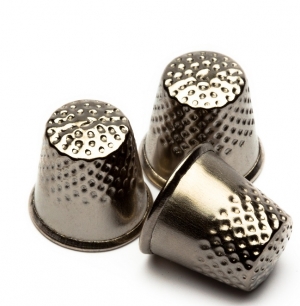The use of thimbles of some kind as a sewing aid dates back thousands of years and there are many different shapes and types. As a generalisation, thimbles tend to be described as either intended for pushing a needle (comparable to a thimble ring, a tailor’s ring or the sewing palm used by sailors making heavy sails), while the more common sewing thimbles are used to push the needle and at the same time to protect against the needle while in use.
The various elements of a thimble are the:
- Crown/cap: the area that forms the lid of the thimble;
- Side: the area between the crown and the rim;
- Rim: a thicker layer of metal, etc., around the base of a thimble to make the thimble stronger and to protect the finger/thumb from a needle that has slipped;
- Indentations (knurling): small, round indentations on the sides and cap of a sewing needle. The word knurling is a general term associated with machine made indentations, grooves or ridges on metal items in general.
There are various types of thimbles, including:
- Finger shields (also known as finger stalls, finger guards or finger protectors): they are made from a ring with a long shield attached to it. They often have a crown or a partial crown, but are open down one long side;
- Quilter’s thimbles: a form of sheath thimble made of two pieces of leather that cover a finger. Often there is a piece of metal or coin sewn into one side of the sheath that is used to push the needle through numerous layers of cloth associated with a quilt of some form;
- Thimble rings: a ring form with no crown. It is similar to a tailor’s thimble, but only about one cm in depth;
- Sewing thimbles: the ‘normal’ thimble with a crown, sides and since the eighteenth century a rim around its lower edge;
- Tailor’s thimbles: open ended thimbles used by tailors to allow them to manipulate the cloth they are sewing;
- Thimblettes: they are used by people handling documents, etc. to protect the fingers against continuous wear. This form is not normally used for sewing, but may be sold in the same category as sewing thimbles
According to the Shorter Oxford English Dictionary, the term thimble derives from the Old English word pymel (thymel) meaning thumb. A story relating to the origins of the word thimble, however, relates how a Dutch metalworker and thimble making factory owner, called John Lofting (Jan Loftingh, 1659-1742, hence Lofting road in London) started making sand-cast thimbles in late seventeenth century England. His 'thumb-bell' gradually changed its name to 'thimble'.
A person who collects thimbles is known as a digitabulist.
Sources:
- BEAUDRY, Mary Carolyn (2006). Findings: The Material Culture of Needlework and Sewing, New Haven: Yale University Press, pp. 91-93
- GROVES, Sylvia (1968; 2nd ed). The History of Needlework Tools and Accessories, Feltham: Country Life Book, pp. 36-41.
- Shorter Oxford English Dictionary: 'Thimble'.
Digital source of illustration (retrieved 8th July 2016).
GVE
